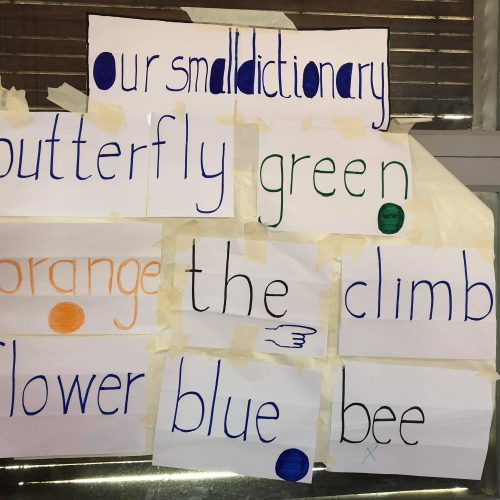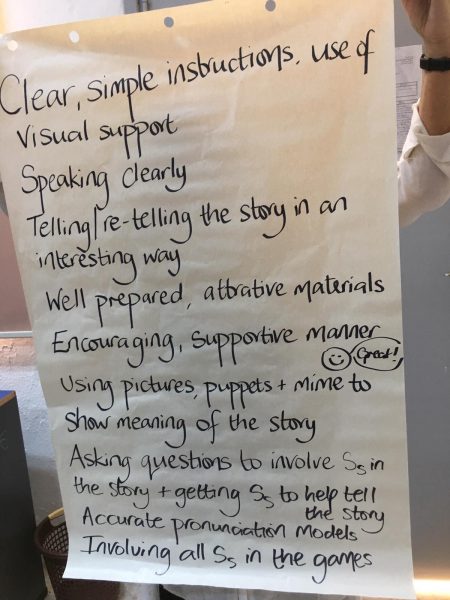Context Setting
Primary English language teacher development programmes are as unique and diverse as the teachers who attend them and the teacher educators who deliver them. That said, in this blog post, I will aim to identify some success factors for programme design based on a primary English teacher development project in Tunisia.
British Council Tunisia recently engaged a training consortium comprised of two educational consultancies specialising in ELT curriculum reform: ELT Consultants and TransformELT. The bespoke, week-long, 30-hour intensive programme designed by the consortium aims to develop approximately 3000 Tunisian Ministry of Education primary English teachers’ classroom skills. This is ultimately to support their transition into working with younger children (grade four of primary school). As is the case in many contexts globally, the age of starting English in Tunisia has recently been lowered in national primary schools.
Crafting Content
If teacher development programmes are to have real and sustainable impact, they should be highly practical and include easy to prepare, minimal cost resources that enable teachers to engage and motivate their learners. The content we crafted for the Tunisia project was inspired by earlier children’s picturebook work in Ellis and Brewster’s (2014) freely downloadable publication, Tell it Again! The Storytelling Handbook for Primary English Language Teachers. Based on this approach, we decided also to use stories as a vehicle for developing children’s English language skills in age-appropriate ways. However, as authentic children’s picturebooks in English are not readily available (or affordable) in many contexts, we also drew inspiration from another freely downloadable resource, Bilbrough’s (2016) Stories Alive! which has teachers’ material for ten stories. The book includes stories suggested by Palestinian English teachers, stories which are well known all over the world and others which originated in the Levant as well as photocopiable story-based language learning activities for children.
As our chosen ‘model story’ for demonstrations during input sessions, we adapted Eric Carle’s world-famous picturebook The Very Hungry Caterpillar (which celebrated its 50th anniversary earlier this year) by simplifying the story and including lexis familiar in the Tunisian context. This functioned as a scaffold for the teachers to collaboratively craft their own culturally relevant stories for use with children in grade 4 English lessons. We also adopted an experiential approach to teacher development when designing and organising the programme. This was implemented by sequencing the content across three 2-hour sessions per day with tutor demonstrations and loop input as the basis of session 1. We followed this with concrete application in session 2 by having the teachers micro-teach the techniques covered during session 1 in groups (alternating between teachers’ and children’s roles). The final session each day took place in the afternoons, during which the teachers combined their new learning from sessions 1 and 2. This involved them writing their own children’s stories for the classroom in graded language. They brainstormed practical ways to integrate their new teaching techniques into a principled story-based lesson plan. This was presented by each group of teachers on the final course day as a culmination and ‘celebration’ of the teachers’ learning from the week.

Being Responsive
Successful development programmes need to be responsive to the needs of the specific teaching and learning context where they take place. For example, the Tunisia programme included 54 teaching advisors (TAs). These are experienced Tunisian primary English teachers who had completed training programmes on primary ELT in the United Kingdom as well as participated in mentoring around the competencies required for teacher educators. During the programme, we enabled the TAs to incrementally facilitate sessions in tandem with the 60 international teacher trainers. These external trainers were selected according to their classroom and in-service work experience with primary teachers of beginner language levels in state schools in lower / middle income countries and/or where resources are limited. As the TAs gained confidence, developed their training skills and deepened their understanding of the programme, they gradually delivered more and more course content with support from the main trainers. In this way, the Tunisia programme embedded both teacher development and trainer development to increase skills in situ for ongoing sustainability.
Focusing on initial literacy in English was another aspect we incorporated during the 5 day course. When first designing the programme, we explored ways initial literacy is taught in both Arabic and French to consider how best to teach children who are learning to read and write in English for the first time. We supported the teachers by providing enjoyable and physical classroom techniques for focusing on directionality when reading and writing, using tramlines for writing, consonant and vowel sounds ‘chunking’ and elements of an adapted Jolly Phonics approach to raise children’s awareness of sound-letter relationships. In addition, there was considerable learning-during-delivery and not just prior-to-delivery in this programme. For example, we learnt that cursive writing predominates with a lot of Tunisian primary teachers, having come from a French language teaching background. Also, the international trainers learnt a lot about aspects of Arabic writing and how when learning it, how the lines are used to position the strokes within, above or below. All of this helped to foster a co-constructed and shared understanding of Tunisian children’s literacy needs in English, which further enriched the programme.

Checking Impact
Large scale teacher development programmes require multiple checks and balances, which on the Tunisia project included teacher focus groups, TA focus groups, input session observations and daily feedback from the teacher training coordinators. This was in addition to daily self-assessment by the consortium partners who constantly asked ‘What can we do better? ’The final day story presentations (where the teachers outlined their lessons based around their story) also provided clear evidence of training and showed that the programme goals had been achieved.

Eliciting Teacher Feedback
These comments are from some of the teachers’ daily reflections and reflect their positive experiences while on the programme:
What surprised me about the programme:
- I can teach four skills in a series of lessons based on a story
- how the trainer makes me love English
- the process involved when teaching a story
- the link between skills and activities and how to prepare story-based lessons
- the simple to make and fun materials
- not just children but also teachers enjoy using stories
- the variety of games to teach English
What and how we learnt about primary ELT:
- the difference between graphemes and phonemes (the name of the letters or symbols English uses and the sounds the symbols make)
- how to teach blending sounds to make words
- the high frequency letters and sounds in English
- the order of the letters of the alphabet is only really useful for dictionary work
- games that help to remember letter and sound (I see something beginning with the sound …)
- exaggerated gestures to teach letter formation in the air, on your palm or back, in the sand
- modeling good letter formation using large word cards
- resources can be made from recycled materials (word / flashcards can be made from cardboard)
- TPR (total physical response) for developing children’s listening sub skills
- games that help children to remember spelling (hungry shark)
- how to tell a story in a motivating way (storytelling not story reading!)

Identifying Success Factors
I would like to end with top ten ingredients for success which can be applied to any primary teacher development programme, as follows:
- Ensure session content is highly practical and classroom relevant.
- Include easy to prepare, minimal cost resources that enable teachers to engage and motivate their learners.
- Help primary English teachers to use and craft stories as age-appropriate vehicles for language skills.
- Source high quality, freely downloadable resources to inspire teachers and support course delivery.
- Provide clear models (via tutor demonstrations) as scaffolding for personalised and collaborative lesson planning.
- Adopt an experiential training approach with loop input, micro-teaching and group work as major course aspects.
- Provide teachers with a clear outcome to showcase their teamwork as well as the new learning and celebrate their achievements.
- Consider the responsiveness of course content throughout by allowing for learning-during-delivery to take place.
- Use a multi-pronged approach to checking programme impact and include all stakeholders.
- Elicit teachers’ feedback about what and how they have learned on a daily basis using reflective reviewing techniques.
See more about the British Council Tunisia Teaching for Success project here: https://www.britishcouncil.tn/en/programmes/education/teaching-success-tunisiaYou can also discover more about the curriculum reform work of both ELT Consultants:https://www.elt-consultants.com and TransformELT:https://transformelt.com/
Resources
Bilbrough, N. (2016). Stories Alive! London: British Council.
Ellis, G. & Brewster, J. (2014). Tell it Again! The Storytelling Handbook for Primary English Language Teachers. London: British Council.

